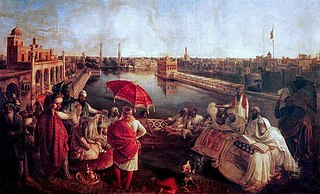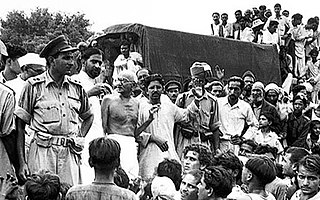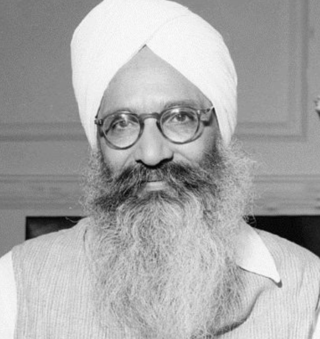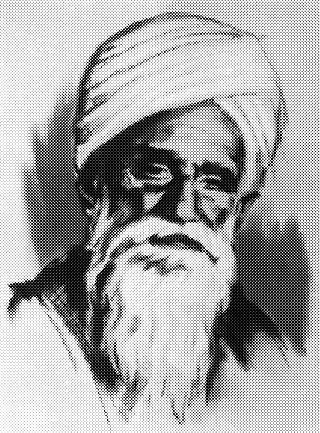Related Research Articles

Sikhs are an ethnoreligious group who adhere to Sikhism, a religion that originated in the late 15th century in the Punjab region of the Indian subcontinent, based on the revelation of Guru Nanak. The term Sikh has its origin in the Sanskrit word śiṣya, meaning 'seeker', 'disciple' or 'student'. According to Article I of Chapter 1 of the Sikh Rehat Maryada, the definition of Sikh is: Any human being who faithfully believes in
- One Immortal Being
- Ten Gurus, from Guru Nanak Sahib to Guru Gobind Singh Sahib
- The Guru Granth Sahib
- The utterances and teachings of the ten Gurus and
- The initiation, known as the Amrit Sanchar, bequeathed by the tenth Guru and who does not owe allegiance to any other religion, is a Sikh.

The Indian Revolution, also known as Indian Independence Movement, was a series of historic events with the ultimate aim of ending British rule in India also known as British Raj. It lasted until 1947.
The Khilafat movement (1919–22) was a political campaign launched by Indian Muslims in British India over British policy against Turkey and the planned dismemberment of the Ottoman Empire after World War I by Allied forces.

Lala Lajpat Rai was an Indian revolutionary, politician, and author, generally known as Lala Lajpat Rai. He was popularly known as Punjab Kesari. He was one of the three members of the Lal Bal Pal trio. He died of severe head trauma injuries sustained 18 days earlier during a baton charge by police in Lahore, when he led a peaceful protest march against the British Simon Commission Indian constitutional reforms.

The first Partition of Bengal (1905) was a territorial reorganization of the Bengal Presidency implemented by the authorities of the British Raj. The reorganization separated the largely Muslim eastern areas from the largely Hindu western areas. Announced on 16 July 1905 by Lord Curzon, then Viceroy of India, and implemented West Bengal for Hindus and East Bengal for Muslims, it was undone a mere six years later. The nationalists saw the partition as a challenge to Indian nationalism and as a deliberate attempt to divide the Bengal Presidency on religious grounds, with a Muslim majority in the east and a Hindu majority in the west. The Hindus of West Bengal complained that the division would make them a minority in a province that would incorporate the province of Bihar and Orissa. Hindus were outraged at what they saw as a "divide and rule" policy, even though Curzon stressed it would produce administrative efficiency. The partition animated the Muslims to form their own national organization along communal lines. To appease Bengali sentiment, Bengal was reunited by King George V in 1911, in response to the Swadeshi movement's riots in protest against the policy.

British Punjab was a province of British India. Most of the Punjab region was annexed by the British East India Company on 29 March 1849, and declared a province of British rule; it was one of the last areas of the Indian subcontinent to fall under British control. In 1858, the Punjab, along with the rest of British Raj, came under the direct rule of the British Crown. It had a land area of 358,355 square kilometers.

The Champaran Satyagraha of 1917 was the first satyagraha movement led by Mahatma Gandhi in British India and is considered a historically important rebellion in the Indian independence movement. It was a farmer's uprising that took place in Champaran district of Bihar in the Indian subcontinent, during the British colonial period. The farmers were protesting against having to grow indigo with barely any payment for it.

The British Raj was the rule of the British Crown on the Indian subcontinent; it is also called Crown rule in India, or Direct rule in India, and lasted from 1858 to 1947. The region under British control was commonly called India in contemporaneous usage and included areas directly administered by the United Kingdom, which were collectively called British India, and areas ruled by indigenous rulers, but under British paramountcy, called the princely states. The region was sometimes called the Indian Empire, though not officially.

Moga district is one of the twenty-two districts in the state of Punjab, India. It became the 17th district of Punjab State on 24 November 1995 cut from Faridkot district. Moga District is among the largest producers of wheat and rice in Punjab, India. People from Moga City and Moga District belong to the Malwa culture. The district is noted for being the homeland for a high proportion of Indian Punjabi expatriates who emigrated abroad and their descendents, which has given it the nickname of "NRI district".
Moga is a city in the Indian state of Punjab. It was made a part and headquarters of the Moga district on 24 November 1995, by the then Chief Minister Harcharan Singh Brar. Before becoming a district, Moga was a part of Faridkot District as a tehsil. Moga is situated on the National Highway 95. The area of Dharamkot block with 150 villages has been merged into Moga district, which falls under the jurisdiction of Ferozpur division.

Partap Singh Kairon was the 3rd Chief Minister of the Punjab province, and is widely acknowledged as the architect of post-Independence Punjab Province. Moreover, he was an Indian independence movement leader. He was jailed twice by the British Empire, once for five years for organizing protests against British rule. His political influence and views are still considered to dominate politics in Punjab.

Sardar Ajit Singh was a revolutionary, an Indian dissident, and a nationalist during the time of British rule in India. With compatriots, he organised agitation by Punjabi peasants against anti-farmer laws known as the Punjab Colonisation Act (Amendment) 1906 and administrative orders increasing water rate charges. He was an early protester in the Punjab region of India who challenged British rule, and openly criticized the Indian colonial government. In May 1907, With Lala Lajpat Rai, he was exiled to Mandalay in Burma. Due to great public pressure and apprehension of unrest in the Indian Army, the bills of exile were withdrawn and both men were released in October 1907.

Baba Sohan Singh Bhakna was a Sikh revolutionary, the founding president of the Ghadar Party, and a leading member of the party involved in the Ghadar Conspiracy of 1915. Tried at the Lahore Conspiracy trial, Sohan Singh served sixteen years of a life sentence for his part in the conspiracy before he was released in 1930. He later worked closely with the Indian labour movement, devoting considerable time to the Kisan Sabha.

The Defence of India Act 1915, also referred to as the Defence of India Regulations Act, was an emergency criminal law enacted by the Governor-General of India in 1915 with the intention of curtailing the nationalist and revolutionary activities during and in the aftermath of the First World War. It was similar to the British Defence of the Realm Acts, and granted the Executive very wide powers of preventive detention, internment without trial, restriction of writing, speech, and of movement. However, unlike the English law which was limited to persons of hostile associations or origin, the Defence of India act could be applied to any subject of the King, and was used to an overwhelming extent against Indians. The passage of the act was supported unanimously by the non-official Indian members in the Viceroy's legislative council, and was seen as necessary to protect against British India from subversive nationalist violence. The act was first applied during the First Lahore Conspiracy trial in the aftermath of the failed Ghadar Conspiracy of 1915, and was instrumental in crushing the Ghadr movement in Punjab and the Anushilan Samiti in Bengal. However its widespread and indiscriminate use in stifling genuine political discourse made it deeply unpopular, and became increasingly reviled within India. The extension of the law in the form of the Rowlatt Act after the end of World War I was opposed unanimously by the non-official Indian members of the Viceroy's council. It became a flashpoint of political discontent and nationalist agitation, culminating in the Rowlatt Satyagraha. The act was re-enacted during World War II as Defence of India act 1939. Independent India retained the law in a number of amended forms, which have seen use in proclaimed states of national emergency including Sino-Indian War, Bangladesh crisis, The Emergency of 1975 and subsequently the Punjab insurgency.

Amba Prasad also known as Sufi Amba Prasad, was an Indian nationalist and pan-Islamist leader notable for his involvement in the agrarian unrest in Punjab in 1907 and subsequently in the Revolutionary movement for Indian independence. Prasad was born in 1858 in the north Indian city of Moradabad, then in the United Provinces. Prasad was born without his right hand. He later worked as a journalist in Moradabad when he became involved in the emerging nationalist movement. He was at this time the editor of the Peshwa. His editorials were noted for sarcastic and unsparing criticisms of the Punjab government policies. He was incarcerated twice in 1897.

The Akali movement, also called the Gurdwara Reform Movement, was a campaign to bring reform in the gurdwaras in India during the early 1920s. The movement led to the introduction of the Sikh Gurdwara Bill in 1925, which placed all the historical Sikh shrines in India under the control of Shiromani Gurdwara Parbandhak Committee (SGPC).
The Jat people are a traditionally agricultural community in Northern India and Pakistan. Originally pastoralists in the lower Indus river-valley of Sindh, Jats migrated north into the Punjab region in late medieval times, and subsequently into the Delhi Territory, northeastern Rajputana, and the western Gangetic Plain in the 17th and 18th centuries. Of Hindu, Muslim and Sikh faiths, they are now found mostly in the Indian states of Punjab, Haryana, Uttar Pradesh and Rajasthan and the Pakistani provinces of Sindh and Punjab.

The Jat reservation agitation was a series of violent protests in February 2016 by the Jat people of North India, especially those in the state of Haryana, which "paralysed" the state for 10 days. The protestors sought inclusion of their caste in the Other Backward Class (OBC) category, which would make them eligible for affirmative action benefits. Besides Haryana, the protests also spread to the neighbouring states, such as Uttar Pradesh, Rajasthan, and the National Capital Region.
The Punjab Canal Colonies is the name given to parts of western Punjab which were brought under cultivation through the construction of canals and agricultural colonisation during the British Raj. The Punjab underwent an agricultural revolution, with arid subsistence production getting replaced by commerce-oriented production of huge amounts of wheat, cotton and sugar. Between 1885 and 1940, nine canal colonies were created in the inter-fluvial tracts west of the Beas and Sutlej and east of the Jhelum rivers. In total, over one million Punjabis settled in the new colonies, relieving demographic pressures in central Punjab.
References
- ↑ Haryana Samvad Archived 27 August 2018 at the Wayback Machine , Jan 2018.